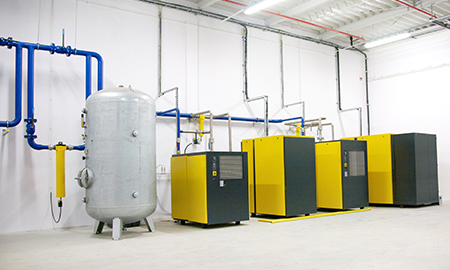All compressors need to be regularly serviced by a competent person using genuine parts and lubricants to ensure they remain reliable and have a long operating life.
The details of exactly what is included in the service of a compressed air system will vary by type of air compressor, its make and model, which type of service is being carried out (major service or minor service) and the current hours run of the compressor. However, regardless of these factors mostly the same generic things are checked or serviced & replaced and these are outlined below.
Air Compressor Checks
- – Run the machine and check machine operation – check the machine is running correctly and there are no major issues with the compressor
- – Check for oil and air leaks – indicate additional issues / faults with the air compressor
- – Check electronic controller (if fitted) for faults in its history – Modern control systems record faults during the compressors running history to ease fault finding when an engineer is on site.
- – Check machine and panels for mechanical damage – mechanical damage to the air compressor from collisions with, for example, fork trucks can highlight potential issues with the air compressor
- – Change oil and air filters – Having clean lubricant is vital to correct operation of the air compressor. The oil filter is designed to remove contaminants and particles from within the lubricant. Keeping the air that is drawn into the air compressor clean and free from contamination and particles reduces internal wear within the compression elements of the air compressor.
- – Change oil and check levels – The air compressor lubricant is vital to correct operation of the air compressor. The lubricant serves many purposes in an air compressor including cooling, sealing, lubrication, removal of condensate. It will slowly degrade over time so needs to be replaced with the correct specification of air compressor lubricant at regular intervals. The correct amount of lubricant is also critical. Too little can result in starvation and overheating too much can lead to internal damage to the compression elements and valves within the air compressor.
- – Check / replace / clean the air / oil separator. Screw compressors inject lubricant into the rotor elements to seal and cool the air as it is compressed. This oily/air mixture is then split in the separator so you are left with oil (which is then cleaned, cooled and recirculated) and compressed air. This splitting occurs in the separator which needs to be cleaned, inspected or replaced depending on type.
- – Take oil sample for analysis – often oil samples are taken and sent to specialist laboratories to identify wearing parts within the air compressor well before faults are seen in daily operation
- – Check / change belts (if fitted) – Drive belts transfer power from the motor to the compressor. Belts wear over time resulting in slip which reduces efficiency and can lead to belt breakage
- – Check operation of valves and clean / refurbish / replace as necessary. There are numerous valves within an air compressor. These are used to control flow of air and oil, aid compressor start-up or run-down amongst other things. These are normally very consistent and reliable. They need to be checked for correct operation and occasionally may need to be replaced or overhauled.
- – Check operation of condensate drain – The condensate drain ensures that any condensate captured within the compressor is drained regularly for efficient operation.
- – Clean the internal air compressor radiators – Air compressors blow a huge amount of air through their radiators to keep the air compressor cool. Inevitably, the radiators over time get blocked with oil, dust and dirt from the atmosphere. Keeping the radiators are kept clean ensures the compressor runs as cool as possible and keeps it working efficiently.
Other equipment checks
- – Check / clean / replace downstream filter elements – Your downstream filters help remove water from the compressed air as well as taking out particulates and excess oil. The main purpose of the downstream filters is to protect your downstream equipment and keep them operating correct
- – Check and clean dryer – Whilst there are not many service parts in your refrigerated dryer giving it a check over, making sure the radiators are clean, the fan is operating correctly and that it is achieving the correct dew point all confirms it is operating efficiently and correctly.
- – Check condensate system operation and clean / replace cleaning elements as required – Your automated condensate system is vital to correct and legal operation of your compressed air system. It is important that the timed / float valves are operating correctly to drain the condensate, it is also important that the condensate cleaner is operating correctly and that the internal filters aren’t blocked or flooded with oil.
Final checks
- – After service restart air compressor and recheck operation – Once all these items have been checked / replaced it is then a case of starting the system and checking everything is operating correctly, that the air compressors is unloading and restarting at the correct pressure, that the dryer is achieving the correct dewpoint and the condensate system is operating correctly
- – Produce report on completion – Finally, it is important that a detailed description of the work done is produced including parts and lubricants fitted and other work done so full traceability and service records of the machine are maintained.
For more information take a look at our online servicing video


